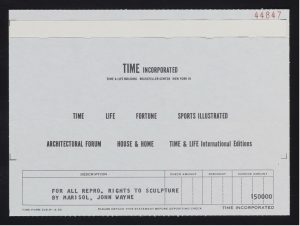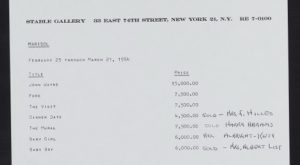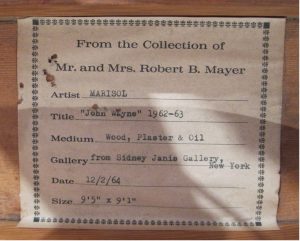By Sadie Burge ’25, Colorado College Student and FAC Curatorial Intern

When you look at Marisol Escobar’s John Wayne (1962-63), you can see more than just a sculpture of a movie star on horseback. The piece is dynamic – it shows John Wayne astride a galloping steed, holding a raised gun. It captures the essence of the larger-than-life Western hero and a pivotal moment in American cinema. But John Wayne isn’t just about the iconic actor. The sculpture speaks to how art interacts with fame, mass media, and cultural history. Marisol Escobar (Venezuelan and American, born France, 1930–2016), most often referred to as Marisol, created works with a striking reflection of Pop Art’s playful relationship with celebrity culture, and its provenance, or the history of its ownership, reveals fascinating layers of meaning behind the artwork.
Marisol and Her Whimsical, Pop Culture Icons
A Venezuelan American, Marisol was born in France in 1930. As an artist, Marisol pushed the boundaries of sculpture, blending wood and plaster with bold colors and shapes to comment on modern life. Her work wasn’t just about the subjects she depicted; it was about how she presented her chosen subjects – often drawn from pop culture. By choosing to portray John Wayne, Marisol wasn’t simply paying homage to the actor; she was commenting on the massive influence of Hollywood and the media on American culture. The piece embodies the persona of the Western hero while acknowledging the ways society elevates celebrities into icons.
Marisol’s style, witty and bold, features playful twists on well-known figures and symbols. And John Wayne is no exception. Marisol’s decision to add whimsical details – like a press photo of John Wayne – shows her unique ability to blend humor with cultural meanings. This fusion of mass media with fine art makes Marisol’s work stand out both in her day, and in ours.

What Is Provenance and Why Does It Matter?
Provenance refers to the history of ownership and exhibition of an artwork. It’s more than just a list of previous owners; provenance tells the story of the art’s journey through time, shaping how it’s understood, valued, and appreciated. Pockets of information come together to create the collage of an object’s life through documents of ownership, exhibition catalogs, newspaper clippings, and even photographs. In the case of Marisol’s John Wayne, these documents, some of which are digitized in this article, allow us to uncover ownership and creation histories. For artists like Marisol, understanding an artwork’s provenance is essential in piecing together the sculpture’s artistic legacy and cultural impact.
In the case of John Wayne, the sculpture’s provenance helps us understand how the piece entered the cultural conversation of the mid-1960s. Marisol completed the work in 1963, just as her career was gaining traction. Despite previous accounts to the contrary, Time Incorporated did not commission the piece. Records show the company bought the reproduction rights to John Wayne for $1,500 in 1963. The piece immediately struck a chord – especially after its reproduction in Life Magazine in the December 1963 issue titled “The Movies.” The sculpture’s prominent placement in Life helped elevate it into a famous and iconic symbol of the Pop Art movement.
The Path of John Wayne since the 1960s
In 1964, the Stable Gallery in New York included the piece in Marisol’s second solo exhibition. Notably, the piece was listed for $5,000, showcasing its growing value in the art world. That same year, Marisol’s relationship with the Stable Gallery ended, but John Wayne continued its journey, appearing in exhibitions, including one at the Aspen Film Institute. Robert and Beatrice Mayer, major patrons of contemporary art, acquired the piece later that year through Marisol’s new representative, the Sidney Janis Gallery.

As part of the Mayers’ extensive and renowned contemporary art collection, John Wayne continued to be part of the conversation about mid-20th-century American art. The sculpture’s appearance in art shows across the world, from Paris to Australia, helped it gain visibility both in the U.S. and internationally. These various exhibitions allowed Marisol’s interpretation of the iconic cowboy to reach diverse audiences, adding new meanings and layers to the piece over time.
The Mayer Family and the Pop Art Connection
Robert and Beatrice Mayer’s acquisition of John Wayne in 1964 was more than just an investment in art. The Mayers were passionate supporters of contemporary art; their collection, which included works by other Pop Art giants like Andy Warhol and Roy Lichtenstein, testifies to their belief in art’s power to shape culture through artistic access.

While Marisol resisted the label of a Pop Artist, her work, particularly John Wayne, fits within the movement as we understand it today. Pop Art was all about blurring the lines between high art and “low culture”, embracing imagery from mass media, advertising, and spaces like Hollywood. By casting John Wayne in sculptural form, Marisol joined the ranks of artists who used popular culture to make bold statements about the world around them. John Wayne became a playful critique of the way Hollywood and the media shape our perceptions of heroism and masculinity.
Why Provenance Is Crucial to Understanding Art
So why does all this matter? Understanding the provenance of John Wayne helps us appreciate the artwork and the broader cultural forces that shaped its journey. The story of who has owned the sculpture, where it has been displayed, and how it has been received gives us crucial insights into how art interacts with society. For instance, with provenance as the background, we can better understand a complex conversation of Pop Art and the American West since the FAC acquired John Wayne in 1978.

Provenance isn’t just a dry record of transactions – it is a map of how an artwork’s significance evolves over time. As John Wayne travels through galleries and museums, gains exposure in media outlets, and is acquired by collectors like the Mayers, its status as a key piece in the Pop Art movement and the FAC’s collection grows and develops. Each step in its journey adds layers of meaning and deepens the cultural and monetary importance of the sculpture.
Through provenance, we understand that art is never static. Art is shaped by the people who own it, display it, and interpret it. And in the case of Marisol’s John Wayne, we see how an artwork’s value and meaning are intimately connected to the cultural forces at play, from mass media to the art world elite.
Conclusion: The Art of Ownership
In the world of art, ownership is power. It is through ownership and display that works like John Wayne solidify their cultural significance. The journey of this sculpture highlights how artworks are both objects to be admired and dynamic players in the story of art and cultural history. Marisol’s John Wayne is not just a representation of a Hollywood icon; it is a reflection of how art, ownership, and culture intersect in the art world and beyond. By looking into provenance, we begin to understand the history of where a piece travels, who’s owned it, and how it’s been presented. Because in the world of art, that’s where the story gets interesting.
If you are interested in learning more about Marisol, I’d recommend reading Marisol: A Retrospective (2023) published by the Buffalo AKG Art Museum.


